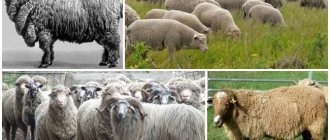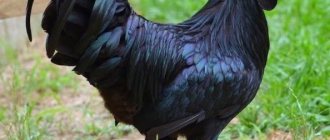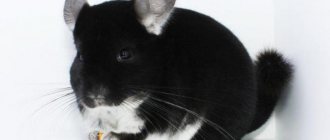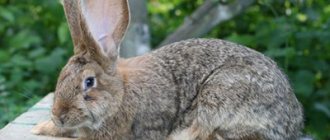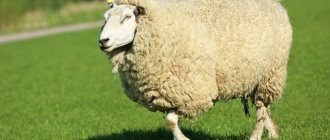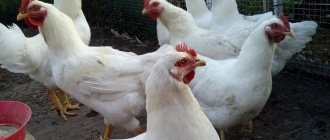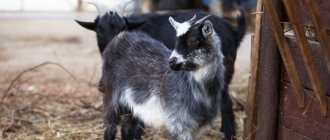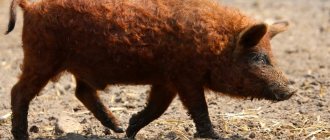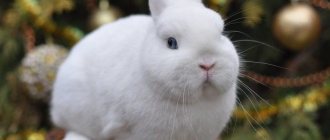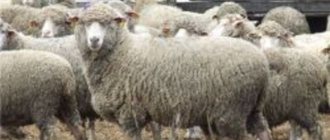Chinchilla rabbits are large animals with a massive, slightly elongated body and a heterogeneously colored silver-blue coat. They are in demand in post-Soviet countries due to their beautiful fur and delicious dietary meat.
Let's figure out what Soviet chinchillas are and how to properly care for them.
History of the subspecies
In 1927, American chinchilla rabbits were brought to the USSR for the first time. They were distinguished by their small size and thick fur. After crossing with large breeds, long and targeted selection, it was possible to increase the weight of chinchillas to 5 kg.
The creation of the new breed involved hybrids obtained from crossing rodents - small chinchillas and White Giant rabbits. A new breed, the Soviet chinchilla, was officially registered in 1963.
The authors of the breeds are considered to be the rabbit breeders of two fur-bearing state farms - “Cherepanovsky” (Novosibirsk region) and “Anisovsky” (Saratov region) and specialists from the rabbit farm of the Rabbit Breeding Research Institute (established in 1932).
Housing
When breeding Soviet Chinchilla rabbits, you should determine the source of profit. Animals can be kept in mesh cages, pits, enclosures, cages with horizontal and level floors, pens, and spacious rooms.
When choosing a place to live, you need to understand the purpose of cultivation. Breeding using the pit method is closest to natural conditions. This method requires a small area and a ditch.
The owner begins to break through passages, and after the animals land, they themselves will continue the work begun by man. Under such conditions, early pregnancy and fertility in female rabbits increases. Childbirth can take place even without owner intervention. The disadvantage of this method is that animals become wild.
When breeding rabbits in pens and enclosures, you should choose a flat, lawn-covered area of land. An awning is pulled up from above. If the sun's rays constantly hit animals, this will lead to their death. Rabbits do not tolerate sweltering heat, high temperatures and direct exposure to the sun very well. The disadvantage of breeding using this method is the weather conditions. The method is great for hot climates.
When breeding animals in cages, you need to choose ventilated, warm rooms. Do not allow cold air currents to enter the room. The cages must be at least 3–4 m2 in area, otherwise the rabbits will not have enough space. And this in turn will lead to joint diseases.
Description of the breed
Soviet chinchilla belongs to the large category breeds. Chinchilla rabbits are easily recognized by their large size and beautiful fur.
Breed constitution
Main external signs:
- The body is massive, strong and slightly elongated. Length – 60-70 cm. The sternum is massive, rounded, girth – 38-40 cm. The back is long, with a curve.
- The paws are large, strong, fleshy.
- The head, in comparison with the large body, is small and neat.
- The ears are erect and of medium length.
An adult rabbit weighs from 4 to 8 kg. Average weight – 5-6 kg.
Fur and skin
Chinchilla fur is considered one of the most expensive in the world. The Soviet chinchilla has soft and fluffy fur. Color – silver-bluish. There are separate white patches on the belly and in the eye area, and a black border on the top of the tail and on the ears. In the back of the head there is a light wedge. The eyes are usually cherry-brown, but blue can also be seen.
The fur of this breed is unique; it is not only dense and beautiful, but also has a unique color. Today there are a lot of scammers who pass off the fur of these rabbits as expensive chinchilla fur. And this is no wonder, because both furs are thick, shiny, and their color is almost the same.
A distinctive feature of the breed is its heterogeneous color.
Main defects
In a litter there are often rabbits with obvious defects. Such animals are immediately rejected and separated from the herd, since they are not suitable for breeding.
The main defects of the breed include the following:
- drooping croup;
- presence of bald spots;
- uneven fur;
- presence of red color in color;
- back with a hump;
- large ears, drooping and “breaking”.
Character
The character of the Soviet chinchilla is excellent; their behavior is no different from smaller rabbits. They are also kind, sympathetic and love affection. But due to their large size, keeping them at home is too problematic.
Similar species
There are several rabbits similar to the Chiinchilla.
Giant chinchilla
The Giant Chinchilla is similar in many ways to the Soviet Chinchilla, but they are even larger and more powerful. The breed was developed by crossing the Flandre with the silver subspecies . They have a rounded body, slightly elongated, and straight, protruding ears.
The color is predominantly light blue. There are snow-white specks around the eyes. The lower part of the body is completely white. The subspecies is profitable for breeding. The weight of individuals reaches 6-7 kg. Maintenance requires spacious cages, freely available water and balanced food.
Orylag
A rabbit bred by French breeders from the best representatives of the Rex breed. It belongs to the Zaitsev family and the Chinchilla order. It is considered the youngest species that was created over the last 100 years.
The French government allocated certain funds for breeding work. Scientists were faced with the task of breeding animal species whose fur would be dense and silky, like that of a chinchilla, but the length of the skin would be much longer.
Viennese
They are similar to their ancestors - the Belgian giants, but they are smaller in size. The weight of one individual is 4.5-5 kg , the body length is usually from 52 cm to 60 cm. Their body is elongated, quite muscular, with powerful bones, a wide chest and a dewlap, which is more pronounced in females. The limbs of rabbits are of medium length, but straight and strong, the head is elongated and proportional in shape. The ears are erect, with rounded edges, their length is up to 15 cm.
The pride of the breed is the high quality of the skin; it is large in size, with a thick coat of unique steel or blue shade. In addition, varieties with black or white fur were bred. The color is uniform, but some individuals have lightened areas in the abdomen and chest.
Newborn babies have gray fur . A bluish tint appears after molting. In the summer, the color of adult individuals sometimes shifts to brownish-brown, but after repeated autumn molting it again becomes normal and familiar to this breed. Females are considered excellent mothers who independently feed their babies. At the same time, the survival rate of the offspring is quite high.
A detailed article about the breed is here.
Economic characteristics
Soviet chinchillas are bred both in small private farms and on large livestock farms. Rabbits quickly pay for themselves, since the demand for bluish fur and dietary meat is always stable.
Economic characteristics of the breed:
- The average cost of a skin is 3,500 rubles.
- Age for slaughter – 3-4 months.
- Lean meat - suitable for children's and dietary nutrition. The meat has a minimal amount of bones and tendons. Fat contains few calories.
- The cost of sexually mature individuals is 3-4 months old, about 1000 rubles.
Chinchilla skins are readily purchased by felt and fur factories.
If you need advice on how to properly tan a rabbit skin at home, this article can be found here.
Productivity
Large rabbits provide not only valuable bluish fur, but also tasty dietary meat. The cubs gain weight quickly; by six months they gain up to 90-95% of their weight. The main productivity characteristics are in Table 1.
Table 1
| Characteristics | Description |
| Male weight, kg | 6-7 kg, maximum – 8 kg |
| Female weight, kg | 5-6 kg |
| Number of cubs per litter | 7-8 pieces |
| Weight of a 2 month old rabbit | 1.9-2 kg |
| Meat yield at slaughter | 58-60 % |
Advantages and disadvantages
The breed was bred as a universal breed, so it is slightly inferior to the meat subspecies. But with good feeding, you can quickly fatten up heavy rabbits.
Advantages of the Soviet chinchilla:
- They quickly adapt to different weather and living conditions.
- High productivity in females.
- Due to their large size they produce a lot of meat.
- Fur is highly valued due to its high quality and unusual color. The density of the fur is twice as high as that of other breeds.
Flaws:
- Spacious cages are needed for maintenance.
- Requires a lot of grain and hay for feeding.
- The farm requires significant expenses.
Pros, cons and reviews
The breed is in demand in our country. This is talked about in all sorts of forums where the advantages and disadvantages of the Soviet chinchilla are actively discussed. The advantages of the breed include :
- cheerful disposition, friendliness;
- high productivity;
- fertility;
- disease resistance;
- endurance;
- not demanding on feed.
As for the shortcomings, the majority of forum users are inclined to believe that they are absent or very insignificant.
Read reviews here and here.
Content options
The Soviet chinchilla, like other rabbits, can be bred using any of the husbandry methods - aviary, cage or pit. Let's take a closer look at all three options.
In the enclosures
This option is suitable for areas with a mild climate and warm winters. When kept in an enclosure, rabbits can be provided with grazing. The problem with this method of keeping is the behavior of rabbits. They are burrowing animals and can make a dig.
Features of the organization of enclosure maintenance:
- You need a free plot of land covered with grass.
- An awning is pulled over the top to protect from the sun.
- Slate is dug in around the entire perimeter of the enclosure to protect against digging, or the floor is covered with a metal mesh.
- Install side feeders. You can’t pour food on the floor, only into feeders, so that the animals don’t get an intestinal infection.
When kept in an enclosure, you don’t have to clean the cages every day. Disadvantage: uncontrolled reproduction and inbreeding.
In cells
Caging is the best option for breeding rabbits with valuable fur. Advantages of the method:
- Possibility of individual feeding and rational use of feed.
- Prevention of consanguinity and birth control.
- Possibility of monitoring animals and timely detection of sick animals.
In warm climates, rabbits can be kept in cages all winter. Where winters are harsh, the animals are transferred to special insulated rabbit hutches.
Features of cell arrangement:
- The cages are placed so that they are not exposed to direct sunlight and cold winds do not blow.
- The length of the cages is approximately 3.5 m. Large animals need space. If rabbits don't move enough, their joints will hurt.
- Materials for cages are wood and mesh. Wooden cages have slatted floors so that droppings fall down.
- Feeders and drinking bowls are attached to the edges of the cages. Learn about making drinking bowls with your own hands from this article.
- A queen cell is made in the breeding cage. In this house, the mother rabbit sets up a nest for her young rabbits. Queen cells can be removable or stationary.
- Cages can be installed in barns - during the cold season. They are also arranged in 2-3 tiers - under a canopy.
In the pits
This method is usually used when raising rabbits for meat. The main disadvantage is the deterioration in the quality of fur. Features of pit arrangement:
- There is straw at the bottom of the pit. They change it regularly. You can also install a mesh floor to allow manure to fall through.
- The walls are blocked with hard materials that rabbits cannot chew through.
- Feeders and drinking bowls are placed along the walls.
- A hole is dug in one of the corners - the animals will subsequently increase its size. The entrance to the hole is blocked by a door, which subsequently facilitates the capture of animals.
- The pit is covered from above - from predatory animals and precipitation.
When kept in pits, rabbits are kept in a favorable microclimate - this is almost a natural habitat. But there is also no birth control here, and there is no possibility of breeding purebred rabbits.
Feeding
Rabbits are herbivorous animals. The diet of animals bred for fur and meat should contain:
- grain and mixed feed;
- green herbs (in summer);
- succulent feed;
- hay (winter);
- boiled potatoes;
- whey;
- bone flour;
- vitamin and mineral supplements.
Features of feeding rabbits:
- When kept at home, the basis of the feed is green food and hay. You should not give branches of stone fruit trees - they contain harmful substances.
- The animals are fed carrots, turnips, raw potato peelings (in small quantities), beets (learned gradually), kale, pumpkin, zucchini, Jerusalem artichoke, cucumbers, and lettuce.
- In order for rabbits to grow well, they are given grain mixtures that include corn, oats and barley. Or they give you mixed feed - in addition to grain, it contains meal, fish or bone meal, and various additives.
- Rabbits can be fed vetch, alfalfa, sweet clover, red clover, and fireweed. The grass is first dried, otherwise digestive problems may occur. Oatmeal, corn and rye sprouts are useful for animals.
- It is allowed to feed wild meadow grasses - nettle, plantain, reeds, yarrow, dandelion, oregano and other edible species.
- Among wild herbs there are many poisonous ones. Do not feed rabbits hemlock, foxglove, celandine, or dog parsley.
Read our additional article on when and what to feed rabbits.
Table 2 shows feed standards for mature rabbits. The composition of feed for adult rabbits is in Table 3.
table 2
| Period | Cereals, g | Bran, g | Hay, g | Green food, g | Table salt, g | Root vegetables, g |
| Winter | 35 | — | 170 | — | 0,7 | 150 |
| Summer | 30 | — | — | 650 | 0,7 | — |
Table 3
| Ingredients | Percentage of rabbit weight, % |
| Oats and wheat crushed | 30 |
| Crushed barley and corn | 45 |
| Bran | 12 |
| Sunflower meal and cake | 12 |
| Chalk | 0,5 |
| Salt | 0,5 |
In order for rabbits to have a good digestive system, they must be given hay or greens. You can feed them with one compound feed in one case - if it contains grass meal.
Rabbit breeding
The Soviet chinchilla has average fertility rates. Females become pregnant several times a year. Sexual maturity occurs at 3.5 months, but to be sure of the offspring, a female 5-6 months old is taken for mating. During the year, the female can participate in mating up to 6 times.
The female estruses every 5-7 days, in winter - once every 8-9 days. During the hunt, the female rabbit behaves restlessly. For mating, the female is placed in a cage with the male, but not vice versa. During mating, the feeder and drinking bowl are removed. To check whether the female is covered, 5-6 days after mating she is again placed in the cage with the male. If she behaves aggressively, it means that fertilization has occurred successfully.
We recommend reading the article about the mating of rabbits, the rules and features of their mating.
Breeding and caring for rabbits
Gestation lasts 26-36 days. 2 weeks before the birth, prepare the place:
- the cage is disinfected;
- large sawdust or straw is sprinkled on the floor;
- change the water regularly - it must be fresh;
- in 10-12 days the female lines the nest - stores fluff and straw; if she does not do this, the rabbit breeder will have to work hard.
They create favorable conditions for a pregnant rabbit - do not make noise, give water and food on time, check her health, do not allow flashes of light, and do not disturb the rabbit without reason.
Childbirth is usually easy and does not require human intervention. Soviet chinchilla rabbits are good mothers and can easily feed up to a dozen babies. Lactation is high - up to 200 ml per day.
There are cases when females behave aggressively and scatter their cubs around the cage. Such female rabbits are subsequently not subjected to mating and are discarded, since it is extremely difficult to feed the young rabbits on their own.
Reasons for aggressive behavior of a female rabbit:
- no milk;
- mastitis;
- another sexual hunt;
- cold indoors;
- lack of nutrients during pregnancy.
Rabbits are born naked, blind and helpless. But even if many babies are born, it is not recommended to give them to other rabbits. Baby rabbits grow quickly on their mother's milk. Survival rate is high. Their eyes open on the 10th day, and on the 15th-20th they leave the nest.
At the age of one month, the rabbits are separated from their mother. By this time, they are able to eat regular rabbit food.
Crossing the Soviet chinchilla with other species
To obtain good livestock for fattening, the Soviet chinchilla is crossed with other breeds. A good result is obtained by crossing female Soviet chinchillas with a male White Giant or New Zealand White.
How to choose the right rabbit?
When buying purebred rabbits for breeding, be sure to look at the documentation, evaluate the appearance, age and health of the animals.
Rules for choosing rabbits:
- If there is no document for the animal, it is extremely difficult to determine the authenticity of the subspecies, especially for novice rabbit breeders. The characteristic color does not appear immediately; it is possible to determine the breed by its coat only after the first molt.
- There must be documentation of vaccinations and examinations by a veterinarian. Their appearance can tell about the health of rabbits. The Soviet chinchilla should have a muscular, large body, and also:
- fluffy wool;
- clear eyes;
- active behavior;
- well-fed body.
- The structure and color of the fur are assessed - they must correspond to the characteristics characteristic of the breed.
- They look carefully to see if there are any defects. Flaws often occur in purebred individuals - they are not suitable for reproduction.
In the video below, the expert talks about the standards of the Soviet Chinchilla rabbit breed:
Criteria and requirements
Young individuals do not differ in pronounced characteristics that are usually used to determine the breed. Therefore, choosing a rabbit based on your own ideas and knowledge is quite difficult.
Based on these considerations, it is recommended to purchase rabbits from trusted breeders, in nurseries where it is possible to check documents. Purebred rabbits have a passport where the parents are indicated. In addition, it makes sense to pay attention to the cost, since the Soviet chinchilla cannot be too cheap.
When purchasing an animal, you need to carefully check its health status. Signs of a healthy individual are the following :
shiny fluffy fur;- clean and clear eyes;
- a good appetite;
- activity.
It is important to check for age-appropriate vaccinations.
Vaccination and diseases
The best way to protect rabbits from diseases is to follow the rules of keeping and timely vaccination. There are diseases that develop so quickly that they lead to the death of rabbits within a day or two.
Rabbits are vaccinated 2 times:
- first vaccination – at the age of 1.5 months;
- the second vaccination – 2-3 months after the first.
The most common diseases of rabbits:
- Coccidiosis. Prevention with anthelmintic drugs is necessary. The disease can lead to the death of animals if not treated promptly. The liver and intestines are affected. The causative agents are single-celled parasites - coccidia.
- Myxomatosis. Tumors appear on the animals' bodies. This disease is viral and is transmitted by blood-sucking insects. Infection also occurs through objects. There is no specific treatment. Sick individuals are eliminated, and the premises are disinfected, imposing a long quarantine. There is only one prevention – vaccination.
- Pasteurellosis. Transmitted by wild birds and rodents. Symptoms are fever, lethargy, loss of appetite. Hemorrhages appear in the internal organs. There is no effective treatment.
Productive qualities
The breed was primarily conceived as a skin breed, and the meat was only a pleasant addition. However, as breeding practice shows, today breeders pursue two goals at once - obtaining skins and meat. The quality of the fur of this breed is on average 1.5 times better than that of ordinary rabbits.
In addition, it has such a shade that it does not require painting to make fur coats, unlike other breeds. The slaughter yield of meat in a 4-month-old rabbit reaches 57%. Despite the fact that it is slightly lower than that of ordinary rabbits (61%), this is just a “pleasant bonus” when raising animals for beautiful fur.
The white giant breed is also classified as a meat-skin breed of rabbits.
Reviews of the Soviet Chinchilla rabbit breed
When industrially breeding Soviet chinchillas, the emphasis is on the fur sector - there is always a demand for cheap fur in Russia, but the consumption of rabbit meat is limited. Small rabbit breeders are more interested in meat, since selling skins in small quantities is problematic.
★★★★★
Konstantin E. 56 years old, amateur rabbit breeder, Moscow region. I've been keeping rabbits for a long time.
Chinchillas are my favorite breed. If you organize their life correctly, then there are no special problems with their breeding. They are gluttonous, but they also gain weight quickly. The skins come out excellent. The breed adapts well to our climate, so I see no point in breeding more expensive breeds - they are all very capricious. ★★★★★
Alexandra, 47 years old, beginner rabbit breeder, Voronezh region. Before breeding rabbits, I read a lot of literature.
Of the many breeds, I immediately chose the chinchilla - I was attracted by its productivity. I got my first rabbits from a rabbit breeder I knew. At first I fed them with special feed, but then it seemed to me expensive, and I began to give them regular feed and corn. My main profit is meat; selling skins is quite difficult.
Hide
Add your review
Soviet chinchilla rabbits are unpretentious and very productive - their owners receive not only high-quality, beautifully colored fur, but also a lot of tasty meat. This breed is suitable for growing in different climatic conditions; even novice rabbit breeders can cope with their breeding.
0
0
Copy link
Breeders reviews
The description is good, but reviews, as they say, are always better. First of all, it is worth noting that breeders note the low demands of animals. They not only pay well for the food they consume, but are also characterized by increased survivability. But for this, as lovers of the breed note, you need to observe the regime, quality of food and hygiene. Reviews especially note that furry animals cannot tolerate dampness, sudden changes in temperature and drafts.
What makes the animals generally attractive is their good character: they are smart, energetic, friendly and curious. They quickly get used to the house. Many people say that this breed is kept as decorative pets because of its beautiful appearance.
